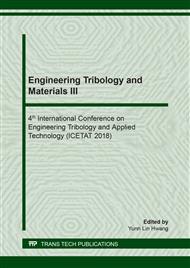[1]
Z. Jamaludin, H. Van, G. Pipeleers, and J. Swevers: Accurate motion control of xy high-speed linear drives using friction model feedforward and cutting forces estimation (CIRP Annal Manufacturing Technology, Vol. 57, 2008), p.403–406.
DOI: 10.1016/j.cirp.2008.03.037
Google Scholar
[2]
N. Rafan, Z. Jamaludin, T. H. Chiew, and L. Abdullah: Study on effect of sigmoid like curves in pre-sliding regime on ball screw driven positioning stage (International Conference on Advances In Civil, Structural and mechanical Engineering, 2014) p.66–70.
Google Scholar
[3]
A. K. Kiss, D. Bachrathy, and G. Stepan: Cumulative Surface Location Error for milling processes based on tool-tip Frequency Response Function (Procedia CIRP, 2016) Vol. 46, p.323–326.
DOI: 10.1016/j.procir.2016.04.015
Google Scholar
[4]
R. Pt, P. Selvakumar, N. Sudhakaran, V. Anirudh, D. L. K, and J. Mathew: Comparative study of roundness evaluation algorithms for coordinate measurement and form data (Precision Engineering, 2018) Vol. 51, p.458–467.
DOI: 10.1016/j.precisioneng.2017.10.001
Google Scholar
[5]
E. D. Tung, Y. Urushisaki, and M. Tomizuka: Low Velocity Friction Compensation for Machine Tool Feed Drives (Proceedings of American Control Conference, 1993) p.1932–(1936).
DOI: 10.23919/acc.1993.4793214
Google Scholar
[6]
Q. Sun, X. Mel, and M. Tsutsumi, in: Analysis of Feed Drive System of XY Table Considering the Friction in Initiatives of Precision Engineering at the Beginning of a Millennium, edited by I. Inasaki, Springer (2002) p.704–708.
DOI: 10.1007/0-306-47000-4_138
Google Scholar
[7]
S. Kaneko, R. Sato, and M. Tstusumi: Mathematical Model of Linear Motor Stage with Non-Linear Friction Characteristics (Journal Advanced Mechanical Design System Manufacturing, 2008) Vol. 2, no. 4, p.675–684.
DOI: 10.1299/jamdsm.2.675
Google Scholar
[8]
J. Yao, G. Yang, Z. Jiao, and D. Ma: Adaptive Robust Motion Control of Direct-Drive DC Motors with Continuous Friction Compensation (Abstract Applied Analysis, 2013) p.1–14.
DOI: 10.1155/2013/837548
Google Scholar
[9]
R. C. Ko and M. C. Good: Improving Contour Accuracy of Machine Tools Using an Integral-Gain Scheduler (Proceeding Institute Mechanical Engineering Part I Journal System Control Engineering, 2005) Vol. 219, no. 7, p.511–518.
DOI: 10.1243/095965105x33581
Google Scholar
[10]
T. Tjahjowidodo, Z. Jamaludin, and S. Shara: Sliding Mode Control For A Frictional System (International Conference on Design and Concurrent Engineering iDecon, 2010) p.100–104.
Google Scholar


